Peregrine Falcon Profile
The peregrine falcon is a bird of prey and one of the larger falcons, with a blue-grey back, a white throat and a black mask.
They are renowned for their speed during high speed dives to hunt prey and can be found nearly everywhere on earth, except extreme polar regions.
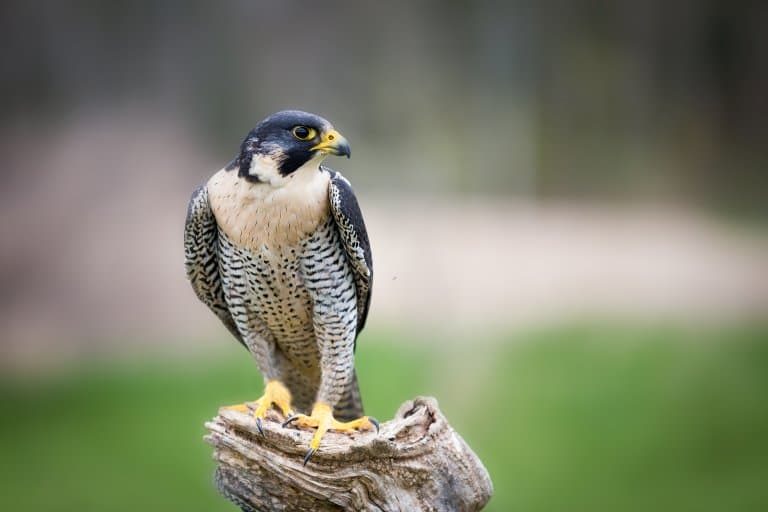
Peregrine Falcon Facts Overview
| Habitat: | Cliff edges or tall city structures |
| Location: | Widely distributed |
| Lifespan: | 6 years |
| Size: | 40-54cm with a wingspan of up to 1m |
| Weight: | 670g – 1.1kg |
| Color: | Dark grey coat with a white chest and abdomen, a white throat and cheeks and a black mask |
| Diet: | Small birds, mammals and large insects |
| Predators: | No natural predators. Gamekeepers and pesticide |
| Top Speed: | 95 kph (60mph) in flight, 389 kph (242 mph) in a dive |
| No. of Species: | 1 with 17-19 subspecies |
| Conservation Status: | Least concern |
In the early twentieth century, the peregrine falcon was targeted by persecution and pesticide poisoning that caused a significant reduction in the number of species. However, in recent years the peregrine falcon numbers have recovered and they have been increasing in numbers.
They can now be found in nest sites in tall city structures (like the falcon from ‘Stuart Little’)
The peregrine falcon typically feeds on smaller birds but they have been known to attempt hunting small mammals and large insects. Interestingly, peregrine falcons hunt whilst they are in flight and can catch their prey in mid-air.
Peregrine falcons are incredible creatures. They are very adaptable and can thrive in areas with a large human population. Younger peregrine falcons look different to an adult peregrine falcon with a dark brown coat and paler ends of their feathers.
Peregrine falcons live and hunt in agricultural land and marshes. They make nests in cliffs, cathedrals or large tower blocks where they have a reliable source of food from pigeons, doves and starlings.
Interesting Peregrine Falcon Facts
1. They are the fastest bird in the world
The peregrine falcon’s streamlined body and pointed wings allow it to reach high speeds in flight and when diving to hunt prey.
It can fly at speeds of up to 95 kph (60 mph) in level flight. While it’s one of the fastest birds for horizontal flight, it’s not the fastest. This accolade goes to the white-throated needletail, a swift which is thought to fly up to up to 170 kph (105 mph).
However, they are the fastest bird in the world when performing dives or ‘stoops’. They have been recorded diving at an incredible speed of 389 kph (242mph), which is in the Guiness Book of Records and also makes it the fastest animal in the world. 1

2. Peregrine falcons can fly 15,500 miles in a year
British peregrine falcons live in their areas all year round. They do not tend to migrate. However female and young peregrine falcons may choose to move during the autumnal seasons.
Some populations in the north and Europe tend to migrate. European falcons can spend a winter in Africa but some chooses to migrate to south America.
Peregrine falcons can fly long distances and travel as far as 15,500 miles in a year. 2
3. Peregrine falcons stun their prey
Peregrine falcons hunt by chasing or diving on to their prey from a great height. This is known as stooping.
Peregrine falcons are extremely fast and because of this, a hunting peregrine will stun its prey before catching it. They are so fast that a blow could injure their prey, making it a far easier capture.
If the prey is too heavy to carry, peregrine falcons will allow their prey to fall and eat it on the ground.

4. Peregrine falcons are biologically adapted for hunting
Peregrine falcons are built for hunting. They have been biologically adapted to hunt their prey. Peregrine falcons have vision that is up to eight times better than the average human and they can spot their prey from more than 3km away.
Additionally, peregrines have a third eyelid that clears debris from their eyes and protects their vision during flight and stooping.
Peregrine falcons have nostrils that prevent high pressure from damaging their lungs during stooping. In fact, their nostrils were the inspiration for the first jet engine designs.
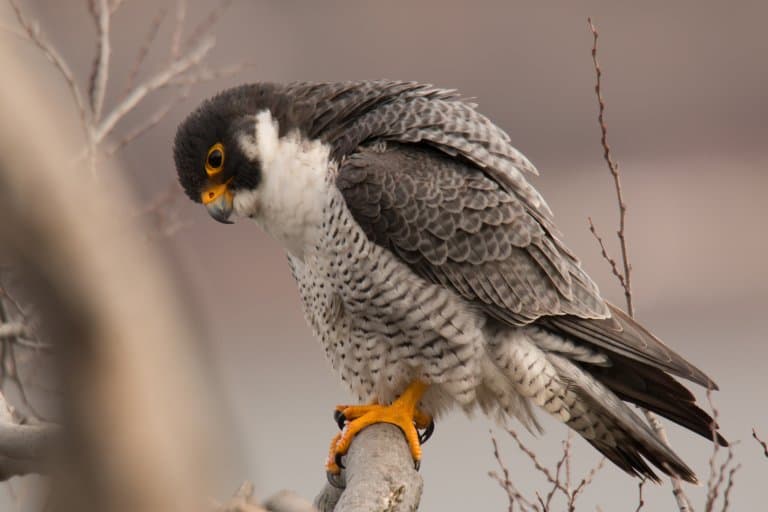
5. Their black ‘tear strip’ helps identify their gender
It runs from their eyes down to their neck. A males strip is usually black, while a females is gray in colour.
6. Peregrine falcons mate for life
Peregrine falcons will mate for life and in February they return to their nests to perform aerobatic displays. The male peregrine falcon will supply the female falcon with food she catches in mid-flight. If she is very confident, she may also fly upside down.
The peregrine female lays her eggs using a scrape she formed from her chest and legs. She will lay up to four eggs in early spring and intubate with them for thirty days whilst the male peregrine provides her with her food.
Young peregrines rely on their parents for 39 days before becoming independent.
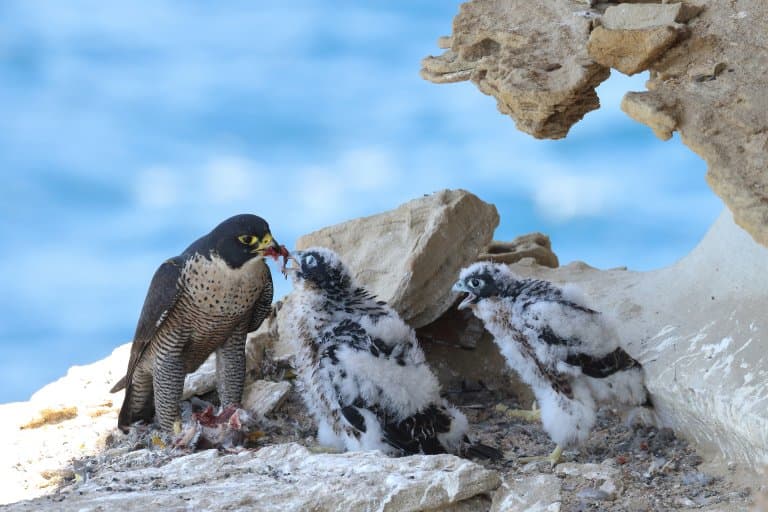
7. Peregrine falcons were heavily persecuted
Peregrine falcons used to be in constant danger from the persecution executed by landowners and gamekeepers in the early twentieth century. In a managed habitat, the peregrine falcon is still less likely to raise young and still have a small risk of persecution.
During World War two to protect the messenger pigeons, peregrine falcons were killed. However, a legislation in 1955 has protected them from being killed and their numbers have improved. 3
8. Pesticides reduced the number of peregrine falcons
Shortly after the law was passed to protect the peregrine falcons their numbers drastically began to decrease. This was eventually found to be caused by pesticides found in agriculture such as DDT.
The peregrine falcon prey would consume these pesticides with their food and when they were eaten themselves, the pesticides would carry through to the falcons. The DDT would cause the eggs of a peregrine falcon to be very thin and they would break before the intubation period was complete. 4
9. The name ‘peregrine’ is from the Latin word ‘peregrinus’, which means ‘wanderer’ or ‘pilgrim’
While both the English and scientific names mean “wandering falcon” in relation to the migratory nature of the north and European falcons.
10. Peregrine falcons are solitary animals
Peregrine falcons are primarily solitary animals and travel great distances independently. Their name describes them perfectly. They are the pilgrim falcons.
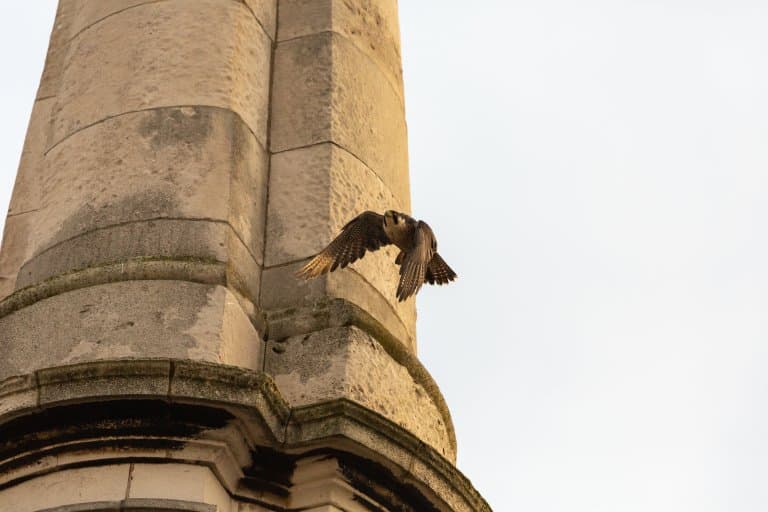
11. Peregrine falcons have been used in falconry for 3,000 years
This began with nomads in central Asia. They are one of the easier falcons to train, and incredible hunters.
They have been used by falconers to scare away birds at airports, to reduce the chances of birds being sucked into airplane engines on take off, and improve air safety.
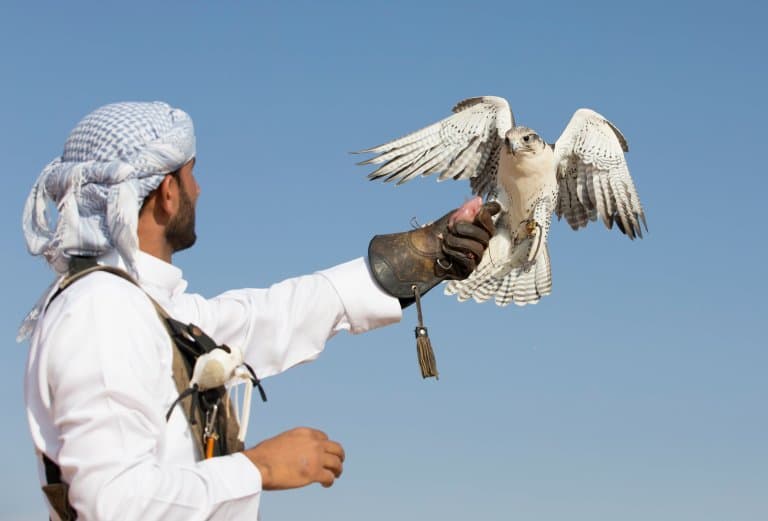
12. Peregrine falcons has cultural significance around the world
They were a symbol of divine authority and royal power in Ancient Egyptian times, and Native Americans have used them in their symobology.
In more modern times the peregrine falcon is the national animal of the United Arab Emirates.
Peregrine Falcon Fact-File Summary
Scientific Classification
| Kingdom: | Animalia |
| Phylum: | Chordata |
| Class: | Aves |
| Order: | Falconiformes |
| Family: | Falconidae |
| Genus: | Falco |
| Species Name: | Falco Peregrinus |
Fact Sources & References
- Fastest bird (diving), Guiness Book of Records, 2005
- OneKindPlanet. 2022. Amazing Facts about Peregrines | OneKindPlanet Animal Education. Accessed 2 May 2022.
- Scottish Wildlife Trust. 2022. Peregrine Falcons. Accessed 2 May 2022.
- Birdguides.com. 2022. Peregrine Falcon – BirdGuides. Accessed 2 May 2022.
